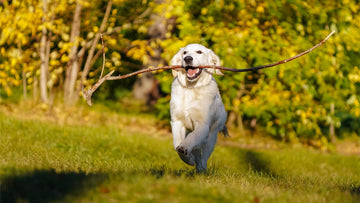When you imagine a perfect day with your furry friend, you probably envision a sunny day in the park, your dog joyfully chasing balls and basking in the warmth. Sunshine indeed benefits our dogs, helping them synthesize Vitamin D and enhancing their mood. However, there's a flip side to this sunny delight: dogs can get sunburned, which can lead to serious skin problems, and in severe cases, skin cancer. In this post, we'll dive deep into understanding sunburn in dogs and share essential tips to prevent and treat it.
Contents
- Why Do Dogs Get Sunburned
- Is Your Dog Prone to Sunburn
- What Are the Symptoms of Sunburn in Dogs
- How to Prevent Sunburn in Dogs
- What to Do If Your Dog Gets Sunburned
- Conclusion
Why Do Dogs Get Sunburned
Much like us, dogs adore soaking up the sunshine, but their sun-worshipping habits can lead to sunburn. The culprit? The sun's ultraviolet (UV) rays. While their fur provides some defense, it's not an absolute shield against the sun's harmful UV radiation. Vulnerable areas with less fur, like the nose, ears, and belly, along with certain breeds, especially those with thin or light-colored coats, are at a heightened risk. Over time, repeated sunburn can lead to serious health issues like skin cancer, emphasizing the importance of sun protection for your pet.
Is Your Dog Prone to Sunburn
Every dog can potentially get sunburned, but certain breeds are more prone to it, especially those with light-colored fur, thin skin, and short hair. These dogs have less melanin, a pigment that protects the skin from the sun's UV rays. Here are some breeds that have a higher risk of sunburn:
What Are the Symptoms of Sunburn in Dogs
Since our canine companions can't tell us when they're feeling sun-scorched, it's our responsibility to watch out for sunburn signs. Recognizing these symptoms early is vital for effective treatment.
"According to a 2020 study published in the journal "Veterinary Dermatology", the most common symptoms in dogs were erythema (redness), edema (swelling), and alopecia (hair loss). Dogs with sunburn were more likely to lick their affected areas."
Here's what you need to keep an eye out for:
- Redness and Swelling: Initial signs of sunburn. The belly, ears, and nose are areas more prone to sunburn and easier to check.
- Pain or Discomfort: Unusual discomfort, constant scratching, licking, or rubbing maybe your dog's attempt to soothe sunburn pain.
- Changes in Skin Texture: Severe sunburn may cause the skin to become dry, peel, or even blister, which can lead to secondary infections if untreated.
- Behavioral Changes: Changes in behavior, like lethargy, irritability, or decreased appetite, might indicate your dog is in pain.
- Sensitivity to Touch: If your dog recoils or growls when you touch a specific area, it could be a sign of sunburn.
Remember, these symptoms may not appear immediately after sun exposure; sunburn can take time to become evident.
How to Prevent Sunburn in Dogs
The best cure, as they say, is prevention. Here are some preventive measures to protect your dog from sunburn:
- Avoid Peak Sun Hours: Try to keep your dog indoors or in a shaded area between 10 a.m. and 4 p.m., when the sun's UV rays are strongest.
- Use Dog-Friendly Sunscreen: Apply a vet-approved, dog-friendly sunscreen on your dog's exposed skin, especially if you plan to be outside for an extended period.
- Dress Your Dog: Doggy sunsuits and hats can provide an extra layer of protection against the sun.
- Regular Vet Check-ups: Regular vet check-ups can help catch any potential issues early before they become serious problems.
What to Do If Your Dog Gets Sunburned
In the unfortunate event that your dog gets sunburned, here are the steps you should take:
As soon as you notice signs of sunburn, it's crucial to remove your dog from direct sunlight. Find a shaded area or bring your dog indoors.
To help soothe the burned skin, apply a cool (but not ice-cold) compress to the affected areas. This can aid in reducing inflammation and provide some relief for your dog.
Ensure your dog drinks plenty of water. Sunburn can leave your dog dehydrated, and keeping them hydrated aids in recovery.
Avoid applying creams or lotions designed for humans on your dog. Some human products can be harmful to dogs. Only use products specifically approved for canine use.
If the sunburn seems severe, or if your dog is in pain or discomfort, reach out to your veterinarian right away. They can recommend appropriate creams, ointments, or other treatments to aid in healing and provide pain relief. It's also important to consult your vet if the sunburn doesn't seem to improve within a few days or if your dog's condition worsens.
Conclusion
Our dogs bring sunshine into our lives, but we need to shield them from the literal rays. Understanding the risks of sunburn, being able to identify its signs, responding promptly to any sunburn incidents, and taking preventative steps are crucial for every pet parent.
Indoor activities can be just as fun and engaging for your dog, reducing the risk of sunburn without compromising their enjoyment.
This summer, let's commit to prioritizing our dogs' health and safety, ensuring that the bright days continue to be a source of joy and not discomfort for our loyal companions. Let's gear up to be sun-smart and look forward to a delightful, sunburn-free summer with our furry friends!






